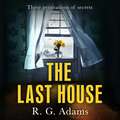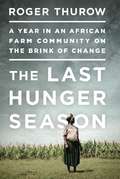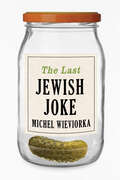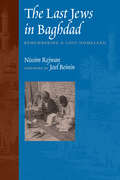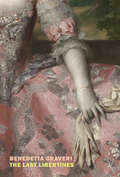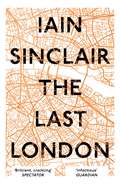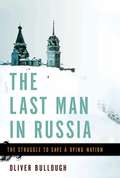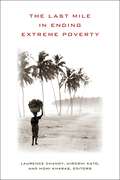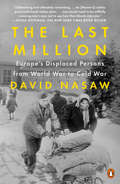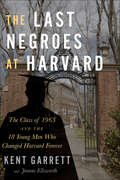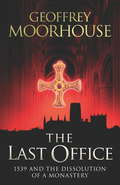- Table View
- List View
The Last House: an intense psychological thriller of locked doors and family secrets
by R. G. AdamsSocial worker Kit Goddard is convinced that Sandbeach Child Services have let an injured seventeen-year-old boy down, just like they'd done to her brother ten years earlier. Since the referral came in, it had been passed between departments, her own manager Georgia and colleague Tim brushing it off as a low risk, low priority case. But Kit can't shake the feeling that something isn't quite right.Scanning the referral, she notices that the house seventeen-year-old Dylan Meredith lives in with his 'weird' mother had been described as decrepit. The anonymous caller said he was injured, frightened and afraid to tell the truth. As Kit begins to look deeper into the history of the family, she learns that Dylan's grandmother had been an inpatient at Penlan psychiatric hospital and had died there in 2012. But as her colleague Tim had stressed, this was not a case for psychiatric services. In a bid to trace the anonymous caller for more information, Kit sets off to the small coastal town of Rock. Only to be confronted with the sense of strangeness that surrounds the Meredith family and the rumours that have troubled this small community for years. An intense psychological thriller, The Last House shows that the darkest secrets are hidden within the walls. But no matter how big you build them the truth will always find a way of breaking out. (P) 2022 Quercus Editions Limited
The Last Human Job: The Work of Connecting in a Disconnected World
by Allison J. PughA timely and urgent argument for preserving the work that connects us in the age of automationWith the rapid development of artificial intelligence and labor-saving technologies like self-checkouts and automated factories, the future of work has never been more uncertain, and even jobs requiring high levels of human interaction are no longer safe. The Last Human Job explores the human connections that underlie our work, arguing that what people do for each other in these settings is valuable and worth preserving.Drawing on in-depth interviews and observations with people in a broad range of professions—from physicians, teachers, and coaches to chaplains, therapists, caregivers, and hairdressers—Allison Pugh develops the concept of &“connective labor,&” a kind of work that relies on empathy, the spontaneity of human contact, and a mutual recognition of each other&’s humanity. The threats to connective labor are not only those posed by advances in AI or apps; Pugh demonstrates how profit-driven campaigns imposing industrial logic shrink the time for workers to connect, enforce new priorities of data and metrics, and introduce standardized practices that hinder our ability to truly see each other. She concludes with profiles of organizations where connective labor thrives, offering practical steps for building a social architecture that works.Vividly illustrating how connective labor enriches the lives of individuals and binds our communities together, The Last Human Job is a compelling argument for us to recognize, value, and protect humane work in an increasingly automated and disconnected world.
The Last Hunger Season
by Roger ThurowAt 4:00 am, Leonida Wanyama lit a lantern in her house made of sticks and mud. She was up long before the sun to begin her farm work, as usual. But this would be no ordinary day, this second Friday of the new year. This was the day Leonida and a group of smallholder farmers in western Kenya would begin their exodus, as she said, “from misery to Canaan,” the land of milk and honey. Africa’s smallholder farmers, most of whom are women, know misery. They toil in a time warp, living and working essentially as their forebears did a century ago. With tired seeds, meager soil nutrition, primitive storage facilities, wretched roads, and no capital or credit, they harvest less than one-quarter the yields of Western farmers. The romantic ideal of African farmers––rural villagers in touch with nature, tending bucolic fields––is in reality a horror scene of malnourished children, backbreaking manual work, and profound hopelessness. Growing food is their driving preoccupation, and still they don’t have enough to feed their families throughout the year. Thewanjala––the annual hunger season that can stretch from one month to as many as eight or nine––abides. But in January 2011, Leonida and her neighbors came together and took the enormous risk of trying to change their lives. Award-winning author and world hunger activist Roger Thurow spent a year with four of them––Leonida Wanyama, Rasoa Wasike, Francis Mamati, and Zipporah Biketi––to intimately chronicle their efforts. InThe Last Hunger Season,he illuminates the profound challenges these farmers and their families face, and follows them through the seasons to see whether, with a little bit of help from a new social enterprise organization called One Acre Fund, they might transcend lives of dire poverty and hunger. The daily dramas of the farmers’ lives unfold against the backdrop of a looming global challenge: to feed a growing population, world food production must nearly double by 2050. If these farmers succeed, so might we all.
The Last Hunger Season: A Year in an African Farm Community on the Brink of Change
by Roger ThurowAt 4:00 am, Leonida Wanyama lit a lantern in her house made of sticks and mud. She was up long before the sun to begin her farm work, as usual. But this would be no ordinary day, this second Friday of the new year. This was the day Leonida and a group of smallholder farmers in western Kenya would begin their exodus, as she said, "from misery to Canaan," the land of milk and honey.Africa's smallholder farmers, most of whom are women, know misery. They toil in a time warp, living and working essentially as their forebears did a century ago. With tired seeds, meager soil nutrition, primitive storage facilities, wretched roads, and no capital or credit, they harvest less than one-quarter the yields of Western farmers. The romantic ideal of African farmers--rural villagers in touch with nature, tending bucolic fields--is in reality a horror scene of malnourished children, backbreaking manual work, and profound hopelessness. Growing food is their driving preoccupation, and still they don't have enough to feed their families throughout the year. The wanjala--the annual hunger season that can stretch from one month to as many as eight or nine--abides.But in January 2011, Leonida and her neighbors came together and took the enormous risk of trying to change their lives. Award-winning author and world hunger activist Roger Thurow spent a year with four of them--Leonida Wanyama, Rasoa Wasike, Francis Mamati, and Zipporah Biketi--to intimately chronicle their efforts. In The Last Hunger Season, he illuminates the profound challenges these farmers and their families face, and follows them through the seasons to see whether, with a little bit of help from a new social enterprise organization called One Acre Fund, they might transcend lives of dire poverty and hunger.The daily dramas of the farmers' lives unfold against the backdrop of a looming global challenge: to feed a growing population, world food production must nearly double by 2050. If these farmers succeed, so might we all.
The Last Indian War: The Nez Perce Story (Pivotal Moments In American History)
by Elliott WestThis newest volume in Oxford's acclaimed Pivotal Moments series offers an unforgettable portrait of the Nez Perce War of 1877, the last great Indian conflict in American history. It was, as Elliott West shows, a tale of courage and ingenuity, of desperate struggle and shattered hope, of short-sighted government action and a doomed flight to freedom. <p><p> To tell the story, West begins with the early history of the Nez Perce and their years of friendly relations with white settlers. In an initial treaty, the Nez Perce were promised a large part of their ancestral homeland, but the discovery of gold led to a stampede of settlement within the Nez Perce land. Numerous injustices at the hands of the US government combined with the settlers' invasion to provoke this most accomodating of tribes to war. West offers a riveting account of what came next: the harrowing flight of 800 Nez Perce, including many women, children and elderly, across 1500 miles of mountainous and difficult terrain. He gives a full reckoning of the campaigns and battles--and the unexpected turns, brilliant stratagems, and grand heroism that occurred along the way. And he brings to life the complex characters from both sides of the conflict, including cavalrymen, officers, politicians, and--at the center of it all--the Nez Perce themselves (the Nimiipuu, "true people"). The book sheds light on the war's legacy, including the near sainthood that was bestowed upon Chief Joseph, whose speech of surrender, "I will fight no more forever," became as celebrated as the Gettysburg Address. <p> Based on a rich cache of historical documents, from government and military records to contemporary interviews and newspaper reports, The Last Indian War offers a searing portrait of a moment when the American identity--who was and who was not a citizen--was being forged.
The Last Investigation: A Former Federal Investigator Reveals the Man behind the Conspiracy to Kill JFK
by Marie Fonzi Gaeton FonziGaeton Fonzi's masterful retelling of his work investigating the Kennedy assassination for two congressional committees is required reading for students of the assassination and the subsequent failure of the government to solve the crime. <P><P>His book is a compelling postmortem on the House Select Committee on Assassinations, as well as a riveting account of Fonzi's pursuit of leads indicating involvement in the assassination by officers of the Central Intelligence Agency.First released in 1993, The Last Investigation was a landmark book upon its release. More than merely an indictment of the Committee's work, Fonzi tells the story of the important leads he developed as an investigator, which sent him into the milieu of Kennedy-haters among anti-Castro exiles and CIA officers. In this highly readable book, the author follows the trail to formerly obscure CIA officers such as David Atlee Phillips and David Morales. New records declassified under the JFK Records Act have only added to the dark questions raised here.
The Last Jewish Gangster: The Early Years
by David Larson“A captivating and different kind of story” about the life of Bugsy Siegel’s godson, from the author “who captured his voice” (Nick Pileggi, author/screenwriter of Goodfellas and Casino).In 1944 Brooklyn, newborn Michael J. Hardy is rejected by his mother so she can run with gangster Bugsy Siegel, Hardy’s godfather. Shirley Rook rose to the top of the criminal ranks. As the Queen of New York City crime, she laundered Mob money, ran the city’s largest bookmaking operation, and handed payouts to dirty cops, politicians, and judges.To win his mother’s love and respect, Hardy became a fearless gangster. Throughout his career as a mercenary, he robbed banks and drug dealers alike, ran a kidnapping ring, and even became a hired gun. At his lowest, he ended up doing time for his mother’s counterfeiting operation in Mexico’s most dangerous prison.Hardy’s criminal code of conduct combines elements of tough Ukrainian Jew and warm Southern Baptist, whether dealing with family and friends or fellow inmates during a combined twenty-six years spent in prisons and jails. He maintained this characteristic gregarious strength throughout his astonishing life in which Hardy was shot eleven times, committed fourteen hits for the Mob, twice wore wires for Rudy Giuliani to nab dirty cops, wrote a letter to JFK to get out of military prison, choked the Hillside Strangler, shared prison time with notorious criminals, and even spent ten years in Hollywood, cast in non-speaking roles in B-movies.“A fascinating character study of an unapologetic criminal. David S. Larson masterfully weaves this tale in Michael Hardy’s own words, resulting in a powerful, inside story of a gangster’s life.” —Cathy Scott, Los Angeles Times-bestselling author
The Last Jewish Joke
by Michel WieviorkaThe golden age of Jewish humour flourished in the second half of the twentieth century, enjoyed by Jews and non-Jews alike, but its twilight years are now in sight. Telling jokes has the potential to reaffirm community once religion, political loyalties and victimhood are stripped away: from the 1960s on, a unique cultural dynamism bound up in these jokes reminded Jews around the world of what it means to be Jewish. Often, jokes pit one group against another, but Jewish jokes opted for self-deprecation instead, and in this case, laughing at the group reinforced it. They enabled Jews to live in harmony with others in full conscience of their differences and they safeguarded a desire for survival at the heart of Jewish identity. Moreover, absurd, larger-than-life characters such as Rabbi Jacob generated tolerance, empathy and tenderness among non-Jews after the horror and guilt of the Shoah. From the early 2000s, however, the space that allowed Jewish jokes to flourish began to shrink, due to a decline in the understanding of the Shoah, a less positive image of Israel and a waning of the importance of Jewish culture in American intellectual and cultural life. This playful and personal book by Michel Wieviorka includes Jewish jokes but also laments the disappearance of the Jewish joke and eulogises its ability to allow the thriving of community alongside difference. It is an original and wide-ranging analysis of the evolution of the diaspora and its relationship with the State of Israel, its history and dramas as well as its cultural creativity.
The Last Jews in Baghdad: Remembering a Lost Homeland
by Nissim Rejwan foreword by Joel BeininOnce upon a time, Baghdad was home to a flourishing Jewish community. More than a third of the city's people were Jews, and Jewish customs and holidays helped set the pattern of Baghdad's cultural and commercial life. On the city's streets and in the bazaars, Jews, Muslims, and Christians-all native-born Iraqis-intermingled, speaking virtually the same colloquial Arabic and sharing a common sense of national identity. And then, almost overnight it seemed, the state of Israel was born, and lines were drawn between Jews and Arabs. Over the next couple of years, nearly the entire Jewish population of Baghdad fled their Iraqi homeland, never to return. In this beautifully written memoir, Nissim Rejwan recalls the lost Jewish community of Baghdad, in which he was a child and young man from the 1920s through 1951. He paints a minutely detailed picture of growing up in a barely middle-class family, dealing with a motley assortment of neighbors and landlords, struggling through the local schools, and finally discovering the pleasures of self-education and sexual awakening. Rejwan intertwines his personal story with the story of the cultural renaissance that was flowering in Baghdad during the years of his young manhood, describing how his work as a bookshop manager and a staff writer for the Iraq Times brought him friendships with many of the country's leading intellectual and literary figures. He rounds off his story by remembering how the political and cultural upheavals that accompanied the founding of Israel, as well as broad hints sent back by the first arrivals in the new state, left him with a deep ambivalence as he bid a last farewell to a homeland that had become hostile to its native Jews.
The Last Legionary: Life as a Roman Soldier in Britain AD400
by Paul ElliottIn AD 400 Roman rule in Britain was collapsing as the thinly stretched empire was beseiged on all sides. In 'The Last Legionary', Paul Elliot explores all aspects of Late Roman military life, from recruitment to weaponry, marriage to wages, warfare to religion. It explores the world of the Roman soldier through the eyes of one man, posted to a British garrison at the edge of the empire, and follows the soldier's life through training and battle, marriage and business dealings, finally following him south as he leaves Britain for good in defence of Rome. When the legionary finally escapes the worst posting in the Roman Empire, it is only to join what effectively beame a death march over the Alps, without food or shelter. To know what it was like to face the chanted battle cry, the charge and slashing axes of the Goths, and to understand why the order 'march out!' was so terrifying, read Paul Elliott's mesmerising, meticulously accurate account.
The Last Libertines
by Benedetta CraveriAn enthralling work of history about the Libertine generation that came up during—and was eventually destroyed by—the French Revolution.The Last Libertines, as Benedetta Craveri writes in her preface to the book, is the story of a group of &“seven aristocrats whose youth coincided with the French monarchy&’s final moment of grace—a moment when it seemed to the nation&’s elite that a style of life based on privilege and the spirit of caste might acknowledge the widespread demand for change, and in doing so reconcile itself with Enlightenment ideals of justice, tolerance, and citizenship.&” Here we meet seven emblematic characters, whom Craveri has singled out not only for &“the romantic character of their exploits and amours—but also by the keenness with which they experienced this crisis in the civilization of the ancien régime, of which they themselves were the emblem.&” Displaying the aristocratic virtues of &“dignity, courage, refinement of manners, culture, [and] wit,&” the Duc de Lauzun, the Vicomte de Ségur, the Duc de Brissac, the Comte de Narbonne, the Chevalier de Boufflers, the Comte de Ségur, and the Comte de Vaudreuil were at the same time &“irreducible individualists&” and true &“sons of the Enlightenment,&” all of them ambitious to play their part in bringing around the great changes that were in the air. When the French Revolution came, however, they found themselves condemned to poverty, exile, and in some cases execution. Telling the parallel lives of these seven dazzling but little-remembered historical figures, Craveri brings the past to life, powerfully dramatizing a turbulent time that was at once the last act of a now-vanished world and the first act of our own.
The Last London: True Fictions from an Unreal City
by Iain SinclairA New Statesman Book of the Year London. A city apart. Inimitable. Or so it once seemed. Spiralling from the outer limits of the Overground to the pinnacle of the Shard, Iain Sinclair encounters a metropolis stretched beyond recognition. The vestiges of secret tunnels, the ghosts of saints and lost poets lie buried by developments, the cycling revolution and Brexit. An electrifying final odyssey, The Last London is an unforgettable vision of the Big Smoke before it disappears into the air of memory.
The Last Maasai Warriors
by Susan Mcclelland Jackson Ntirkana Wilson MeikuayaHow two young Maasai tribesmen became warriors, scholars, and leaders in their community and to the world.They are living testament to a vanishing way of life on the African savannah. Wilson and Jackson are two brave warriors of the Maasai, an intensely proud culture built on countless generations steeped in the mystique of tradition, legend and prophecy. They represent the final generation to literally fight for their way of life, coming of age by proving their bravery in the slaying of a lion. They are the last of the great warriors.Yet, as the first generation to fully embrace the modern ways and teachings of Western civilization, the two warriors have adapted -- at times seamlessly, at times with unimaginable difficulty -- in order to help their people. They strive to preserve a disappearing culture, protecting the sanctity of their elders while paving the way for future generations.At this watershed moment in their history, the warriors carry the weight of their forbearers while embracing contemporary culture and technology. While their struggle to achieve this balance unfolds exquisitely in this story, their discoveries resonate well beyond the Maasai Mara.
The Last Man Standing: The chilling apocalyptic thriller that predicts Italy's collapse
by Davide LongoA chillingly plausible novel about the collapse of Italian society and one man's struggle to retain his humanity amid the horror"A bleak, lyrical tale that evokes Cormac McCarthy's The Road.... Gruesome, intense, and strange... a eurozone nightmare brought to life on the page."--James Lovegrove, Financial TimesIt is 2025, and Italy is on the brink of collapse. Borders are closed, banks withhold money, the postal service stalls. Armed gangs of drug-fuelled youths roam the countryside. Leonardo was a famous writer and professor before a sex scandal ended his marriage and career. Heading north in search of her new husband, his ex-wife leaves their daughter and her son in his care. If he is to take them to safety, he will need to find a quality he has never possessed: courage.
The Last Man Standing: The chilling apocalyptic thriller that predicts Italy's collapse
by Davide LongoA chillingly plausible novel about the collapse of Italian society and one man's struggle to retain his humanity amid the horror"A bleak, lyrical tale that evokes Cormac McCarthy's The Road.... Gruesome, intense, and strange... a eurozone nightmare brought to life on the page."--James Lovegrove, Financial TimesIt is 2025, and Italy is on the brink of collapse. Borders are closed, banks withhold money, the postal service stalls. Armed gangs of drug-fuelled youths roam the countryside. Leonardo was a famous writer and professor before a sex scandal ended his marriage and career. Heading north in search of her new husband, his ex-wife leaves their daughter and her son in his care. If he is to take them to safety, he will need to find a quality he has never possessed: courage.
The Last Man in Russia: The Struggle to Save a Dying Nation
by Oliver BulloughRussia is dying from within. Oligarchs and oil barons may still dominate international news coverage, but their prosperity masks a deep-rooted demographic tragedy. Faced with staggering population decline--and near-certain economic collapse--driven by toxic levels of alcohol abuse, Russia is also battling a deeper sickness: a spiritual one, born out of the country’s long totalitarian experiment. In The Last Man in Russia, award-winning journalist Oliver Bullough uses the tale of a lone priest to give life to this national crisis. Father Dmitry Dudko, a dissident Orthodox Christian, was thrown into a Stalinist labor camp for writing poetry. Undaunted, on his release in the mid-1950s he began to preach to congregations across Russia with little concern for his own safety. At a time when the Soviet government denied its subjects the prospect of advancement, and turned friend against friend and brother against brother, Dudko urged his followers to cling to hope. He maintained a circle of sacred trust at the heart of one of history’s most deceitful systems. But as Bullough reveals, this courageous group of believers was eventually shattered by a terrible act of betrayal--one that exposes the full extent of the Communist tragedy. Still, Dudko’s dream endures. Although most Russians have forgotten the man himself, the embers of hope that survived the darkness are once more beginning to burn. Leading readers from a churchyard in Moscow to the snow-blanketed ghost towns of rural Russia, and from the forgotten graves of Stalin’s victims to a rock festival in an old gulag camp, The Last Man in Russia is at once a travelogue, a sociological study, a biography, and a cri de coeur for a dying nation--one that, Bullough shows, might yet be saved.
The Last Men on Top
by Susan JacobyA feminist--and the bestselling author of The Age of American Unreason--looks back at the last pre-feminist generation of men who supposedly had it all and asks: what exactly did they have?How fabulous was life for men in the 1950s and early 1960s? How real is the world depicted by a television show like Mad Men: a world where visibly successful males, so long as they supported their families and contributed to their firms' profitability, could have midday liaisons, impregnate secretaries, and pimp for clients with impunity? In this engaging, witty, and insightful reappraisal, Susan Jacoby challenges both versions of the story--narratives that either romanticize or demonize men's lives back in the good or bad (you choose) old days. She suggests that there were hidden economic and psychological costs that made this "Rat Pack" reality a fantasy, and she also shows why this illusion still holds sway in the worldview of many (including Republicans and social conservatives such as Mitt Romney) who continue to cherish, long for, and advocate for the days when a family lived on the man's paycheck, and the woman stayed at home where she belonged.Our most unsparing chronicler of unreason and an impassioned social provocateur, who is always eager to skewer intellectual laziness and cultural myths, comes to the unexpected rescue of the last generation of prefeminist men. An electronic dart of wit and insight.
The Last Mile in Ending Extreme Poverty
by Homi Kharas Laurence Chandy Hiroshi KatoThe past quarter century has witnessed a stunning reduction in the number of people around the world living on less than $1.25 a day, the marker for extreme poverty. This has led to a new sense of hope that extreme poverty can be eradicated within a generation. Yet optimism is tempered by the unique circumstances facing those who remain left behind and new challenges that weaken traditional paths to prosperity. The Last Mile in Ending Extreme Poverty explores what it will take to finish the course. It identifies three critical challenges that define the last mile: securing peace, creating jobs, and strengthening resilience. These are issues that development experts have largely overlooked, on which cutting-edge knowledge is blunt and best-practice solutions feel decidedly underwhelming.By uncovering evidence and approaches to address these issues--and while pointing out the knowledge gaps that remain--The Last Mile outlines an agenda to inform development research and poverty reduction strategies for governments, international organizations, donors, charities, and foundations around the world.Contributors: Michael Carnahan (Department of Foreign Affairs and Trade, Government of Australia), Raj M. Desai (Georgetown University and Brookings), Shane Evans (Department of Foreign Affairs and Trade, Government of Australia), Akio Hosono (JICA), Bruce Jones (Brookings), Marcus Manuel (Overseas Development Institute), John McArthur (Brookings and UN Foundation), Alastair McKechnie (Overseas Development Institute and University of Otago), Gary Milante (Stockholm International Peace Research Institute), Yoichi Mine (JICA and Doshisha University), Ryutaro Murotani (JICA), John Page (Brookings), Go Shimada (University of Shizuoka, JICA, Columbia University, and Waseda University), Stephen C. Smith (George Washington University and Brookings)er disasters, Go Shimada, JICA-RI Social protection and the end of extreme poverty, Raj Desai, Georgetown University and Brookings
The Last Mile in Ending Extreme Poverty
by Homi Kharas Laurence Chandy Hiroshi KatoViewed from a global scale, steady progress has been made in reducing extreme poverty-defined by the $1.25-a-day poverty line-over the past three decades. This success has sparked renewed enthusiasm about the possibility of eradicating extreme poverty within a generation. However, progress is expected to become more difficult, and slower, over time. This book will examine three central changes that need to be overcome in traveling the last mile: breaking cycles of conflict, supporting inclusive growth, and managing shocks and risks. By uncovering new evidence and identifying new ideas and solutions for spurring peace, jobs, and resilience in poor countries, The Last Mile in Ending Extreme Poverty will outline an agenda to inform poverty reduction strategies for governments, donors, charities, and foundations around the world.ContentsPart I: Peace: Breaking the Cycle of Conflict External finance for state and peace building, Marcus Manuel and Alistair McKechnie, Overseas Development Institute Reforming international cooperation to improve the sustainability of peace, Bruce Jones, Brookings and New York University Bridging state and local communities through livelihood improvements, Ryutaro Murotani, JICA, and Yoichi Mine, JICA-RI and Doshisha University Postconflict trajectories and the potential for poverty reduction, Gary Milante, SIPRIPart II: Jobs: Supporting Inclusive Growth Structural change and Africa's poverty puzzle, John Page, Brookings Public goods for private jobs: lessons from the Pacific, Shane Evans, Michael Carnahan and Alice Steele, Department of Foreign Affairs and Trade, Government of Australia Strategies for inclusive development in agrarian Sub-Saharan countries, Akio Hosono, JICA-RI The role of agriculture in poverty reduction, John McArthur, Brookings, UN Foundation, and Fung Global InstitutePart III: Resilience: Managing Shocks and Risks Environmental stress and conflict, Stephen Smith, George Washington University and Brookings Toward community resilience: The role of social capital after disasters, Go Shimada, JICA-RI Social protection and the end of extreme poverty, Raj Desai, Georgetown University and Brookings
The Last Mile: Turning Public Policy Upside Down (Innovations, Practice and the Future of Public Policy in India)
by Amarjeet SinhaThe Last Mile explores the gaps and dichotomy between drafted policies and their implementation, and the last mile challenges which often make public services inaccessible to the poorest and most vulnerable sections of society. It provides an in-depth overview of the dynamics between communities, research and consultation and the implementation of policies for development. Rich in empirical data and case studies from different government programmes and reports, this book examines the implementation of government service programmes for poverty reduction, women’s empowerment, and income generation for the poor, among others, from a people’s perspective. It highlights the need for policies and institutions to align their methods to community needs. Offering guidelines for redesigning as well as solutions to counter challenges related to lack of trust and effective communication, human resource management, capacity development, redressal mechanisms, and facilitating the last mile connection, the author delineates effective ways for integrating new technologies in policy implementation. The book also addresses legacy issues in institutions and re-orienting policy for better governance, transparency, and building trust. Part of the Innovations, Practice and the Future of Public Policy in India series, this book, by a senior practitioner, will be an essential resource for students and researchers of development studies, sociology, public policy and governance, economics, and South Asian studies. This book is freely available as a downloadable Open Access PDF at http://www.taylorfrancis.com under a Creative Commons (CC-BY-NC-ND) 4.0 license.
The Last Million: Europe's Displaced Persons from World War to Cold War
by David NasawFrom bestselling author David Nasaw, a sweeping new history of the one million refugees left behind in Germany after WWIIIn May 1945, German forces surrendered to the Allied powers, putting an end to World War II in Europe. But the aftershocks of global military conflict did not cease with the German capitulation. Millions of lost and homeless concentration camp survivors, POWs, slave laborers, political prisoners, and Nazi collaborators in flight from the Red Army overwhelmed Germany, a nation in ruins. British and American soldiers gathered the malnourished and desperate refugees and attempted to repatriate them. But after exhaustive efforts, there remained more than a million displaced persons left behind in Germany: Jews, Poles, Estonians, Latvians, Lithuanians, Ukrainians, and other Eastern Europeans who refused to go home or had no homes to return to. The Last Million would spend the next three to five years in displaced persons camps, temporary homelands in exile, divided by nationality, with their own police forces, churches and synagogues, schools, newspapers, theaters, and infirmaries. The international community could not agree on the fate of the Last Million, and after a year of debate and inaction, the International Refugee Organization was created to resettle them in lands suffering from postwar labor shortages. But no nations were willing to accept the 200,000 to 250,000 Jewish men, women, and children who remained trapped in Germany. In 1948, the United States, among the last countries to accept refugees for resettlement, finally passed a displaced persons bill. With Cold War fears supplanting memories of World War II atrocities, the bill granted the vast majority of visas to those who were reliably anti-Communist, including thousands of former Nazi collaborators and war criminals, while severely limiting the entry of Jews, who were suspected of being Communist sympathizers or agents because they had been recent residents of Soviet-dominated Poland. Only after the controversial partition of Palestine and Israel's declaration of independence were the remaining Jewish survivors able to leave their displaced persons camps in Germany.A masterwork from acclaimed historian David Nasaw, The Last Million tells the gripping yet until now largely hidden story of postwar displacement and statelessness. By 1952, the Last Million were scattered around the world. As they crossed from their broken past into an unknowable future, they carried with them their wounds, their fears, their hope, and their secrets. Here for the first time, Nasaw illuminates their incredible history and, with profound contemporary resonance, shows us that it is our history as well.
The Last Nazi Trials
by Moritz Vormbaum80 years after the Nuremberg trial, the prosecution of Nazi perpetrators has effectively come to an end. Examining the last Nazi trials in Germany from a multidisciplinary perspective, the present volume addresses key aspects of the judicial phenomenon of Spätverfolgung (‘late prosecution’), links the issue to the international discourse on transitional justice, and contributes to current debates in academia and society at large.
The Last Neanderthal: Understanding How Humans Die
by Ludovic SlimakIt’s August 2015. After twenty-five years of archaeological research in a secluded cave overlooking the Rhône Valley in southern France, Ludovic Slimak uncovers the remains of a Neanderthal, frozen in time – a discovery that casts fresh light on a critical turning point in human history. Could these remains belong to one of the last Neanderthals? As scientists from around the world analyze the site, their findings disrupt everything we thought we knew about the final days of these ancient humans. This discovery takes us to the defining threshold when multiple human species, once coexisting in the same world, are wiped from history—leaving Homo sapiens as the sole human survivor.Slimak takes the reader on an extraordinary journey of discovery that is both scientific and profoundly human, blending rigorous research with evocative storytelling. This breathtaking exploration of the past not only unearths the lost world of the Neanderthals but forces us to confront the unspoken question: is this how humanity dies? A compelling narrative spanning millennia, The Last Neanderthal is both a groundbreaking scientific revelation and a profound reflection on the fragility of humanity and the threads that connect us to the distant past.
The Last Negroes At Harvard: The Class of 1963 and the 18 Young Men Who Changed Harvard Forever
by Kent Garrett Jeanne EllsworthThe untold story of Harvard’s class of ’63, whose Black students fought to craft their own identities on the cusp between integration & affirmative action.In the fall of 1959, Harvard recruited an unprecedented eighteen “Negro” boys as an early form of affirmative action. Four years later they would graduate as African Americans. Some fifty years later, one of these trailblazing Harvard grads, Kent Garrett, would begin to reconnect with his classmates and explore their vastly different backgrounds, lives, and what their time at Harvard meant.Garrett and his partner Jeanne Ellsworth recount how these eighteen youths broke new ground, with ramifications that extended far past the iconic Yard. By the time they were seniors, they would have demonstrated against national injustice and grappled with the racism of academia, had dinner with Malcolm X and fought alongside their African national classmates for the right to form a Black students’ organization.Part memoir, part group portrait, and part narrative history of the intersection between the civil rights movement and higher education, this is the remarkable story of brilliant, singular boys whose identities were changed at and by Harvard, and who, in turn, changed Harvard.
The Last Office: 1539 and the Dissolution of a Monastery
by Geoffrey MoorhouseHenry VIII's dissolution of the monasteries, through the never-before-told story of how one priory was saved and become Durham's mighty cathedralWhat happened to the monks, their orders and the communities they served after Henry VIII's break with Rome in 1536? In THE LAST OFFICE Geoffrey Moorhouse reveals how the Dissolution of the Monasteries affected the great Benedictine priory at Durham, drawing for his sources on material that has lain forgotten in the recesses of one of our great cathedrals. The quarrel between Henry VIII and the papacy not only gave birth to the Church of England but heralded the destruction of the 650 or so religious houses that played a central role in the spiritual and economic life of the nation. Durham proved to be the exception. On New Year's Eve 1539, the monks sang the last compline. Next morning the priory and its community were surrendered into the hands of the King's commissioners. But then nothing happened. An interregnum lasted 16 months before the priory was reborn as the new cathedral church of Christ and the Blessed Virgin, part of the new Church of England. The Prior became the Dean and 12 monks were retained as prebendaries. In Geoffrey Moorhouse's original and absorbing study, one of the great catalytic events of our past comes alive through the personalities and events at one key monastery.
